I was introduced to Karen Navarro’s photographs before the I met the artist herself. I was invited to jury Houston Center for Photography’s Learning Curve 11 in September 2018. I had nearly completed reviewing all of the photographs submitted by students who had taken classes or workshops at HCP’s Learning Center when I encountered Karen’s photographs, and I was immediately impressed by their strength and singularity. I finally met Karen at the opening events and have remained in contact with her since.
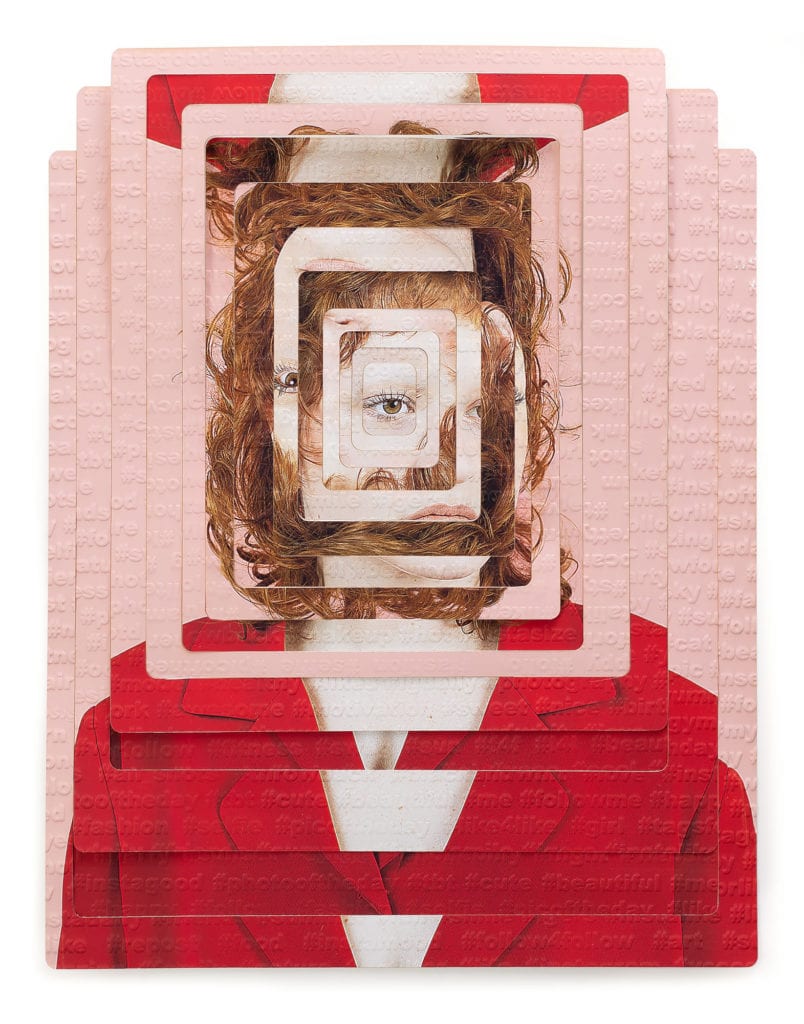
Haley Berkman Karren: I first found your work when I juried Houston Center for Photography’s Learning Curve 11, an exhibition that highlighted a diverse group of photographers who had excelled in classes or workshops at HCP’s Learning Center. I was so intrigued with your work that I included two of your photographs in the exhibition, and even installed one of them on the title wall.
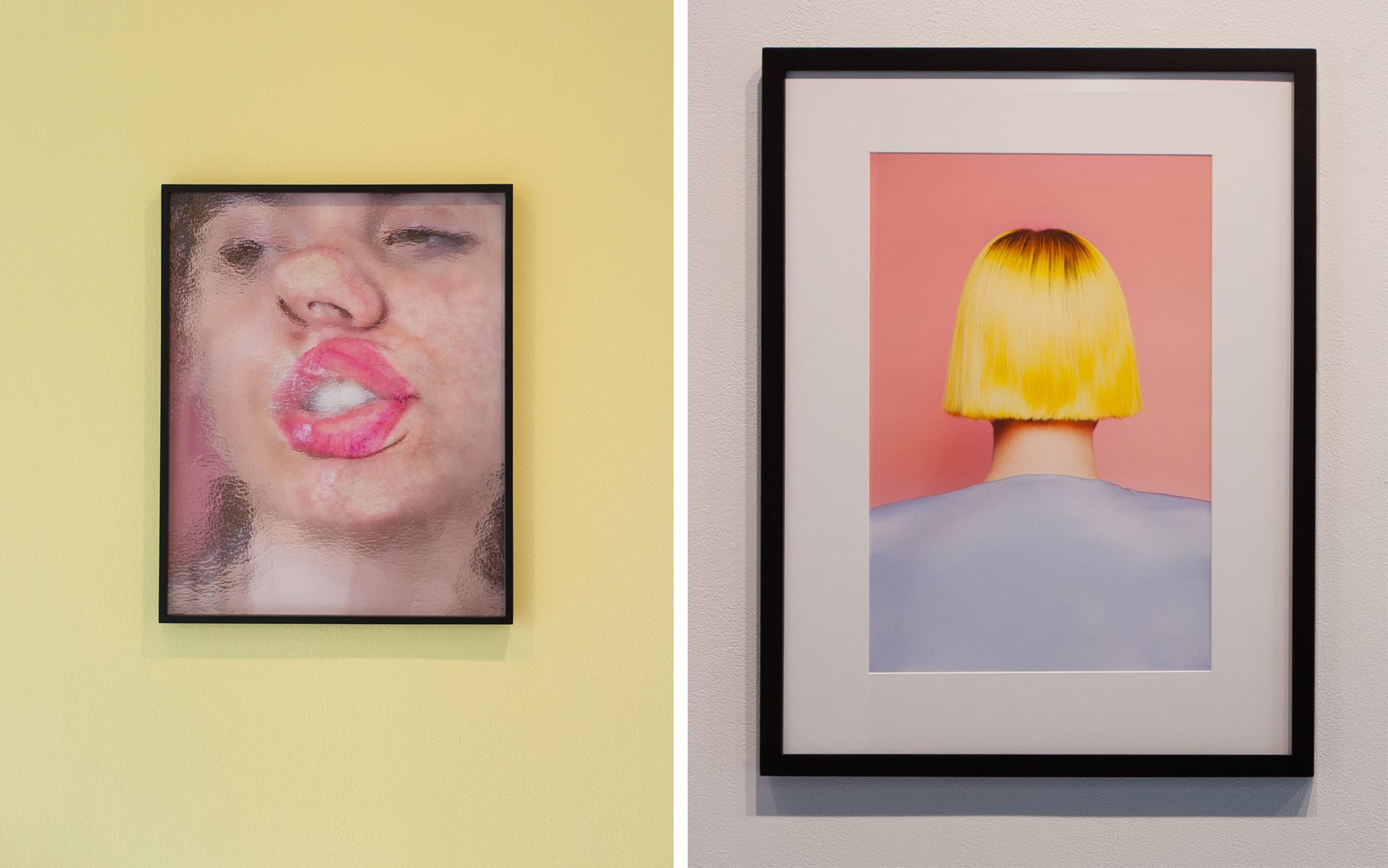
I’ve come to your studio today to discuss your newest series, El Pertenecer en Tiempos Modernos (Belonging in Modern Times). This series of portraits explores how self-representation through social media creates belonging. Inspired by Cubism and materiality, you collage composed portraits in strips, circles, and cubes at varying dimensions. You also emboss the works with the top 100 hashtags at the time you created the work, further manipulating the texture of the image and relating back to larger issues of self-representation and social media—the constructed self through the constructed image.
Can you tell me about the inspiration behind this series?
Karen Navarro: I have been wondering why I feel that I have—or want—to post pictures on Instagram, and why I feel such satisfaction from receiving likes. We spend so much time online now that, in a way, I feel like everything has changed. The way we relate and connect has historically been in the physical world and now, it is in the digital world. I see many examples on social media of influencers or celebrities with perfect lives and many followers and I wonder why so many people want access to all of that. Why is it that for some people, success is defined by the number of followers they have on Instagram?
We believe what we see on Instagram; however, it may not be real. We all want happy, perfect lives but that is not real life. It is hard, it takes courage, and almost no one actually shows what life really is because we want to have the illusion of a perfect world. And I do too. So,why do we rely on social media? Why do we want to belong? When we try to belong, when we try to assimilate to a group of people, we lose ourselves. The online “us” is an illusion of ourselves; it is what we want to portray. It is hard to be real, it is hard to be ourselves, and it is hard to define all of the things that are really important to us when we are being bombarded all the time with confusion. How is success defined—by the number of likes, or is it something else? Everything is linked, in a way. These questions led to the creation of this body of work. It was my intent not to offer answers, but to pose questions and expose truths simultaneously.
HBK: I agree that Instagram can be an illusion. I also think that it is interesting to note that I first learned about this series through your Instagram account, but I was even more intrigued when I saw a few of these works in person at Lawndale. Instagram can clearly be an incredible tool for artists and curators!
KN: Instagram is a tool for me as an artist. I feel like I have to take advantage of the tools I have. I do not have a personal Instagram account, for example. And I think that if you are using it as a tool to promote art and to promote yourself as an artist, it can bring you a lot of positive results.
HBK: I agree. When you set up these images, did you tell people what to wear?
KN: Yes. I opened a call on Instagram and Facebook. I use pink and blue because those are the colors of the social media logos. Blue is for Facebook and for many other social media logos, such as Twitter, and pink is for the Instagram logo.
HBK: The Instagram gradient.
KN: Yes, it is a gradient, but it is mostly pink with yellow and blue.
So I asked them to bring one accessory and an article of clothing that was either blue or red, depending on the platform from which communication was initiated. If we connected via Facebook, they would bring something blue and vice versa. I decided that unifying the participants in this particular color scheme would bring them together in a way that emphasized a sense of belonging.
Have you seen trends on Instagram where everyone is basically taking the same pictures?
HBK: Yes, of course.
KN: When I see people taking the same photographs, I feel like everyone loses a little part of their identity. This series investigates the need to replicate others. Perhaps, it is a quest to belong; a desire to feel a part of a bigger whole. A desire to be accepted by one’s peers.
HBK: So, you placed this call. How many people did you want to photograph for this series?
KN: I actually didn’t have a number in mind. I knew that I wanted to start with at least fifteen and that the series could always expand. Ultimately, I asked people to send me a picture of themselves and I selected from there, choosing the people that stood out to me the most. I also wanted them to have a similar look in the way they were posing.
This work was an investigation, actually, because I did not completely know what I wanted to do at the very beginning. The work was leading me until I got to a point of understanding and was able to take the work further.
HBK: After you found your subjects, you photographed them in your studio with the red and blue articles of clothing and accessories that you suggested in front of a pinkish background. From these sessions, you picked one image of each person that you embossed with the top one hundred hashtags of that day, further linking the work to social media.
KN: Yes, I created the embossing plate with the hashtags and embossed each photograph. Then, I laser cut the photographs and re-assembled them.

HBK: As viewers, we are all so drawn to the text that it literally and figuratively pops out. The embossing helps your eye find the text, especially in moments when it is harder to read, like in the red, or on a face.
One of the ways that this series relates to Cubism is through your use of collage.
KN: I think I made this work to break some rules in the photography world and to challenge the medium. This series is a point of experimentation for me as well—an introduction to sculpture, which is something I want to explore in the future. I want to push the boundaries of not only photography, but my art practice as well. I feel like this thinking aligns with the Cubist mentality because Cubism was drastically breaking away from existing modes of thinking.
HBK: Cubism was one of the first major shifts away from realism. It was the depiction of the inner state, a break from reality. At that point, the camera had been invented, so there was no need to create representational art anymore.
KN: And also, because it was contradictory. The clashing of different angles were representational yet abstract at the same time. Cubism had so many different layers of meaning, which made it so rich. Looking at the artwork did not just reveal one thing; it was an introduction to a different world that questioned reality.
Not only do I admire the Cubist mindset, but also their inclusion of text in the collages to add deeper meaning. This is another reason why I decided to include the text.
HBK: That is a great point. Many Cubist artists would use newspaper, and particularly, whatever newspaper was out that day. The artists would pull the headlines and the dates, which they incorporated into their work,so it is very easy for us as art historians to link back to the specific day and know exactly where a particular artist was, what they were doing, and what they were looking at.
You are doing exactly that in an updated way, by taking the top 100 hashtags of the day you created the work which is so of the moment.
Were there any Cubist works in particular that you were looking at? Or was it Cubism in general that was on your mind?
KN: Cubism and Surrealism. I find myself referencing these movements constantly. Sometimes, the reasoning behind why I do certain things feels unknown, but really, it is often a result of what I’ve always known—Cubism and Surrealism—and what I have seen.
HBK: I really love the dynamic shape you’re creating with these interlocking circles.
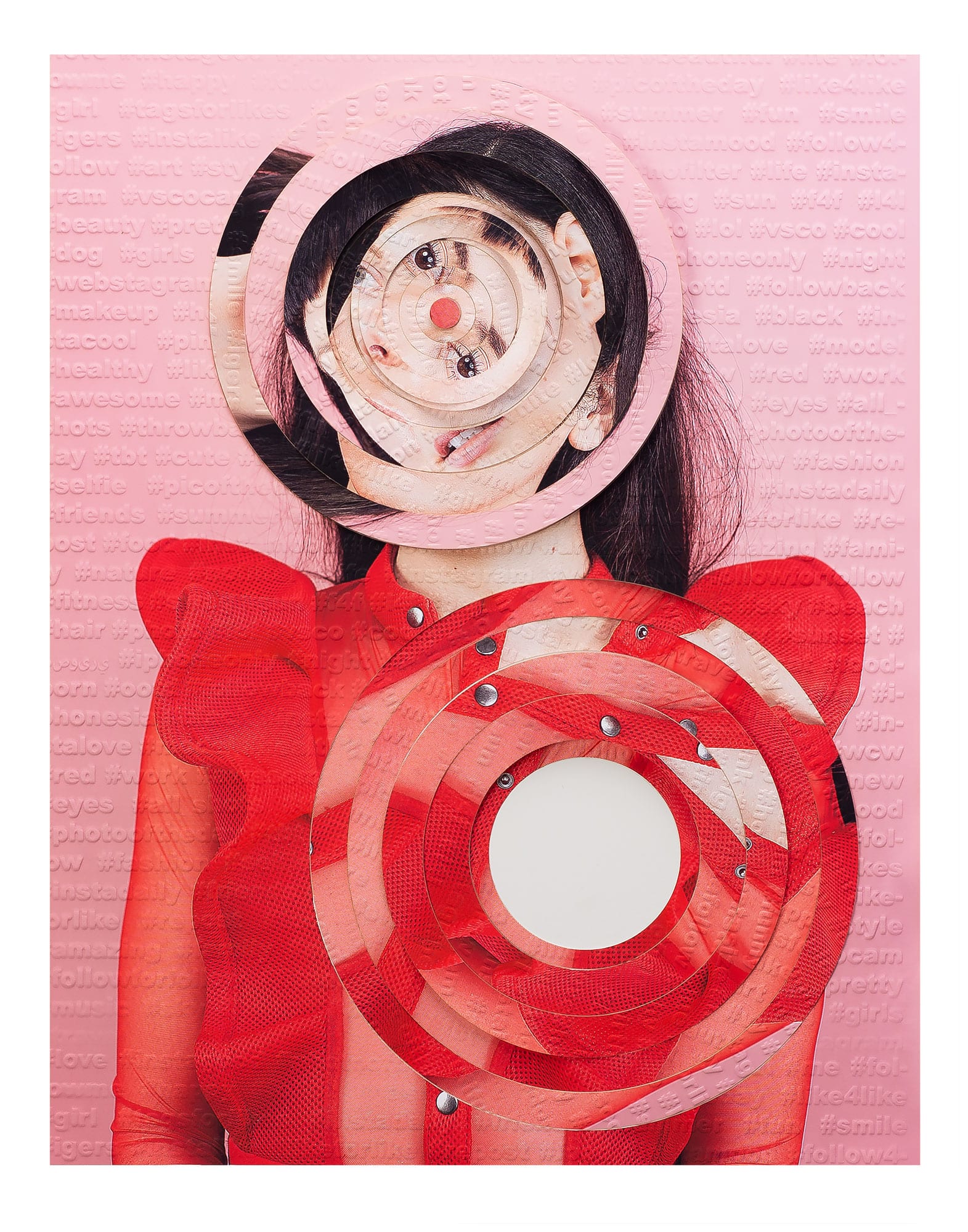
KN: Optical illusion is another link between my work and Cubism.
HBK: Exactly, and the varying lines and planes that interact and overlap
HBK: You used acrylic box frames, which creates these very sculptural shadows.
KN: The work changes depending on the lighting, too. I like the interaction that it has with the environment, because depending on the lighting, the hashtags may look more or less visible.
HBK: How did you decide how to cut and reassemble the photographs?
KN: It was actually kind of random and mostly based on aesthetics. After laser cutting the work into pieces, I was able to physically rearrange the work into a composition that felt right.
HBK: You are playing with depth as well.
KN: Yes, I printed 3D shapes to achieve three-dimensionality. I printed with this 3D printer that I still haven’t totally figured out yet.
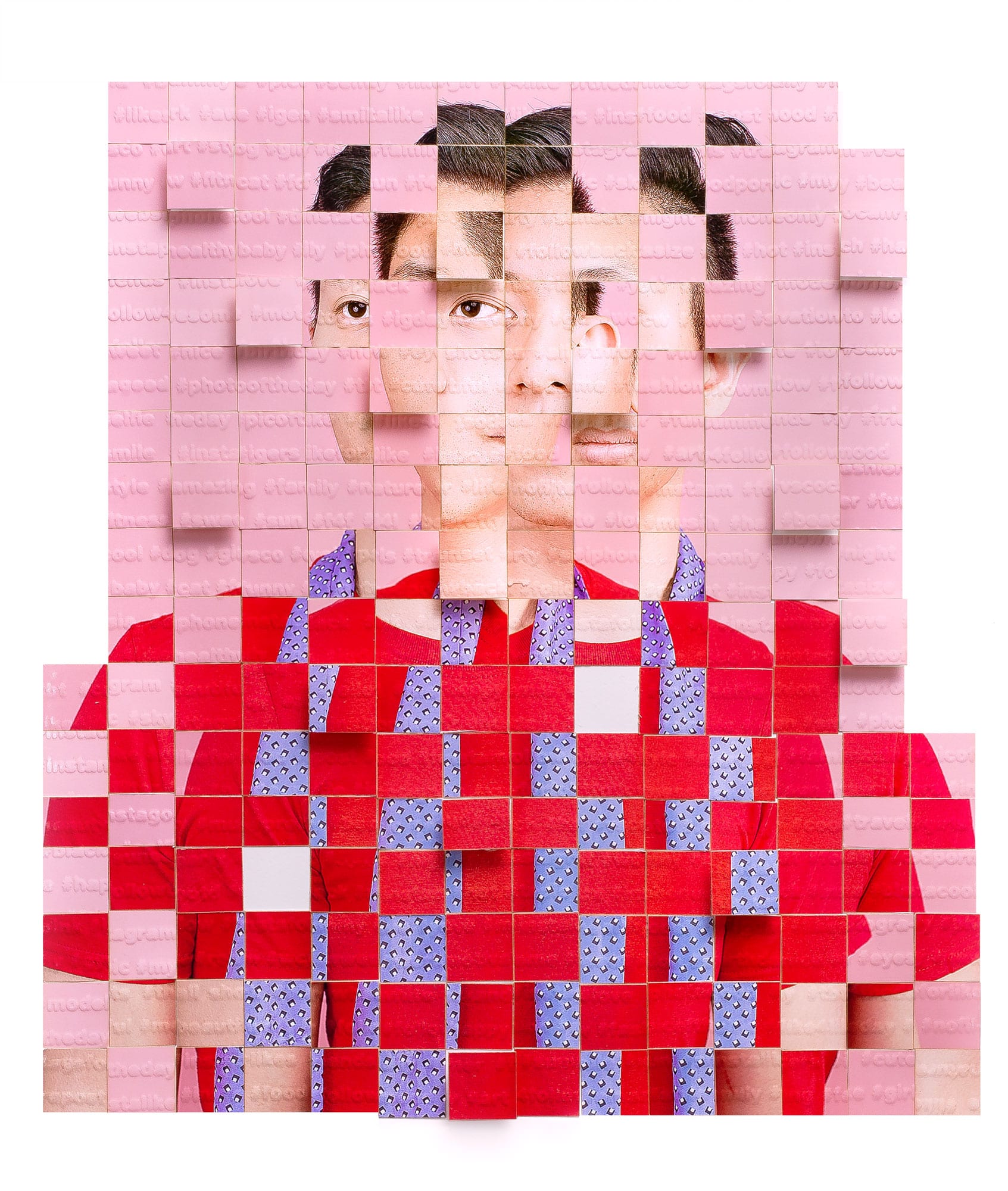
HBK: I love the way that it is just slightly off.
KN: I like this idea of constructing a new identity on social media, of distorting and creating a different version of who you are. That is why I decided to manipulate the images, to create a character, a different version of yourself, something that is intrinsically different.
HBK: In the way that you’re conceptualizing this series, the pink background is the constant, the common denominator in the group. How are you considering this lavender piece, Subject #1?
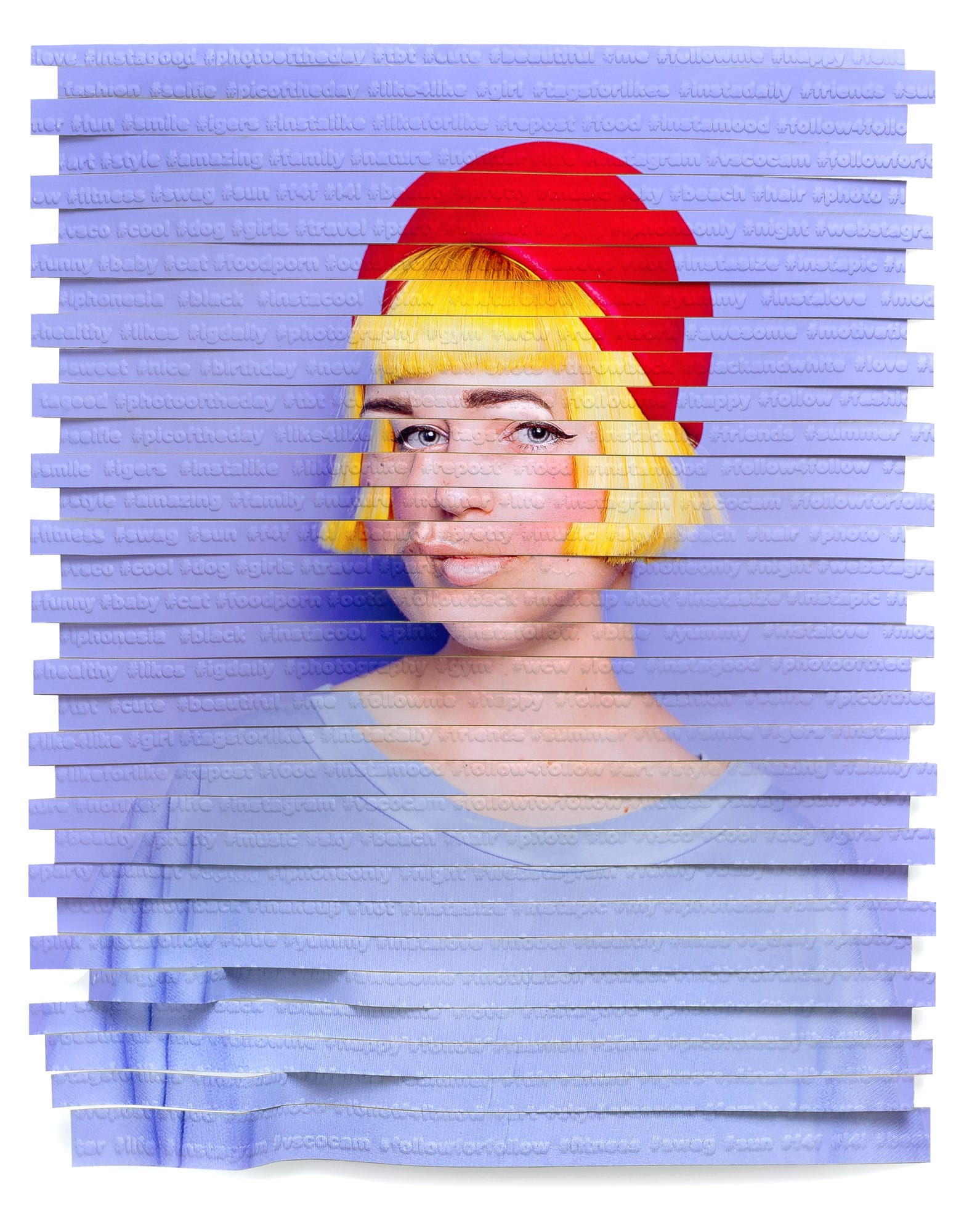
18 x 14 in
KN: The lavender piece was the first one I shot. I took the picture only to return to it when deciding to create this series. The lavender piece does not belong to this specific group. She may belong to another group. They share some commonalities between them, including color and repetition, but she is different.
HBK: I just love the depth, that little moment on the bottom left side where the cut paper sort of curls up.
KN: I call it a glitch. It happened by accident, so it was perfect.
HBK: Sometimes those are the best moments for artists—something unexpected —and being able to move forward with that.
KN: I like when unexpected things happen because often, you are so focused on materializing the work you have imagined in your mind. . However, when the unexpected happens it becomes clear that you can do things differently and that they could become more interesting.
The process for making a body of work changes for me. It isn’t always the same. I always allow the work to show me things that I do not see. It is a journey. I embrace the unknown.
HBK: So, what is next? How are you going to build off of this series?
KN: I haven’t decided yet, but I will probably expand the series in a different direction and work more sculpturally.
Karen Navarro (b. 1990) is an Argentine artist working with a highly stylized aesthetic on a diverse array of mediums that includes photography and collages. Her constructed portraits are known for the use of color theory, surreal scenes and minimalist details. Navarro’s work explores themes related to identity and femininity. It expresses self-referential questions that connect in a much larger scale to ideas of social construction of reality. Navarro works and lives in Houston since 2014.

